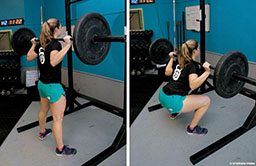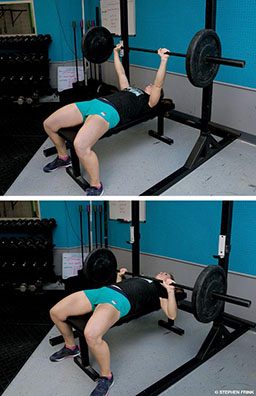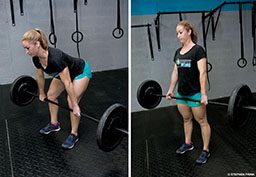It’s not your imagination: Your 50-60 pounds of scuba gear feels heavier as you age. Sedentary people can lose as much as 5 percent of their muscle mass each decade after age 30. This muscle loss is called age-related sarcopenia.
Don’t worry — this is, to some degree, preventable. All you have to do is participate in a strength-training program three days per week. Most age-related loss of muscle mass occurs in fast-twitch fibers, so target these fibers with heavier weight and more explosive movements. First, however, you must master proper form. A weight-training program that targets the muscles most used diving will allow you to do multiday dives without undue strain or fatigue.
Strive to complete three sets of 10 for each of the following foundational lifts. To promote good form, be sure to allow sufficient rest in between attempts. Once these foundational lifts are mastered (i.e., the movements are mapped in your brain) you will be able to shorten your rest periods without risking injury. Always make sure you use collars on bars with weights to keep the plates from slipping off.
Barbell Back Squat

The squat is an important move for scuba divers because it involves a large part of the muscular system and mimics standing with full scuba gear. This move targets the quadriceps, gluteals, adductors, spinal erectors, abdominals and hamstrings. Strength in these muscles allows you to begin dives with a lower heart rate and blood pressure and less stress.
- Start with the barbell on the squat rack, and position it to rest on your trapezius muscles (traps) — not on the vertebrae in your neck.
- Grasp the bar in a comfortable position, and pull your elbows back.
- While looking at a point straight ahead, lift the bar off the rack.
- Take a step or two back away from the rack.
- Set your feet at shoulder width (or slightly wider) with your toes pointed slightly outward.
- Slowly bend your knees, sitting back until your thighs are parallel or almost parallel to the floor, and keep your weight in your heels.
- Return to a standing position.
Tip: Maintain a straight back by bending at your hips — not bending your spine.
Modification: Start by bending your knees to 45 degrees (a quarter squat). Progress gradually toward achieving a 90-degree bend in your knees.
Challenge: Gradually increase your range of motion (ROM) by going deeper into the squat. When your pelvis begins to rotate, tucking the tailbone, you have reached the extent of your ROM.
Bench Press

The bench press targets the pectorals and also strengthens the triceps, anterior deltoids, serratus and coracobrachialis. These muscles can be useful when exiting the water into an inflatable tender.
- Lie supine on a bench with your feet flat on the floor.
- Grip the barbell with your hands slightly wider than shoulder width.
- Slowly lower the bar to your chest.
- Press the weight back up.
Tips: Breathe throughout the movement, inhaling as you lower the barbell and exhaling as you lift. Focus on five points of contact: your head, shoulders, butt and feet. If your back arches during the lift, this may indicate excessive strain.
Challenge: Try changing your grip to target different muscles.
Dead Lift

Like the squat, the deadlift targets many large muscle groups. The engagement of the back and hip muscles facilitates propulsion through the water.
- Stand facing the bar with your feet slightly wider than shoulder width and your shoelaces under the bar.
- Flex your knees and hips until you can reach the bar.
- Grasp it with an alternate grip (one palm out, one palm in).
- Exhale, and stand straight up without locking your knees.
Tips: Bend at your hips; don’t bend your spine. Bending at your spine places excess strain on your back. Try to have the barbell travel in a straight line upward — its path should be vertical with no forward or backward movement. Use less weight and/or rest between sets to train your body to use good form.
Challenge: Minimize rest between repetitions — have the plates “kiss” the ground for just a moment.
Military Front Press

This exercise targets your deltoids, traps and elbow/forearm flexors. Strength in these muscles can make it easier to pick up and carry gear.
- Grip the barbell in a comfortable position, and rest it on your upper chest.
- Press the barbell straight upward.
- Lower the barbell to the starting position.
Tip: Maintain a slight bend in your elbows throughout.
Challenge: Gradually increase the repetitions and/or weight as appropriate.
Bent-Over Barbell Rows

This exercise targets the latissimus dorsi, teres major, posterior deltoids, elbow flexors, rhomboids and traps. Strengthening theses muscles makes it easier to handle heavy equipment and facilitates climbing a ladder in full gear.
- Stand with your knees slightly flexed, bending at the hips to maintain a flat back while positioning your trunk at a 45-degree angle.
- Grip the bar slightly wider than shoulder width, with your arms hanging straight down from your shoulders.
- Bring the bar up to your chest, then slowly lower it.
Tip: Contract your abdominals to maintain a flat back.
Challenge: Increase weight and/or repetitions.
NOTE: To avoid an increased risk of decompression sickness, DAN® recommends that divers avoid strenuous exercise for 24 hours after making a dive. During your annual physical exam or following any changes in your health status, consult your physician to ensure you have medical clearance to dive.
| © Alert Diver — Q2 2017 |